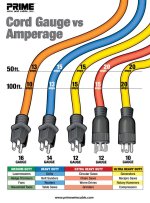Ok that's not quite accurate, but close enough. I am bringing home an electric soil sterilizer and will be plugging it into a 4 prong dryer outlet. It draws 12 1/2 amps at 240 volts and the electrical rating is 3000 watts. I will be converting from 3 to 4 prong, but that's a pretty straightforward fix... as long as I follow the directions. (Hook 3 wires up the way the old ones were... ground the green to the appliance.) I do need the cord to be longer than a standard dryer cord though so am not sure what size wire to use; 20 feet will allow me to set it up in a trailer or the back of my pickup, and do multiple batches of soil.
My question is, can anyone tell me what wire to use; or send me to a chart which will give me the info I need?
Thank you in advance.
My question is, can anyone tell me what wire to use; or send me to a chart which will give me the info I need?
Thank you in advance.

